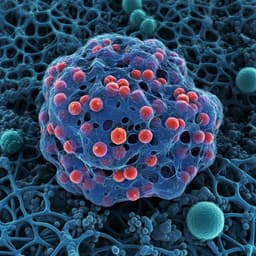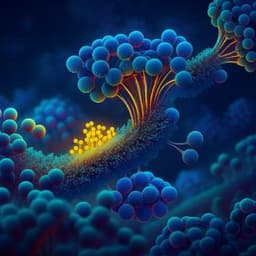
Chemistry
Multi-responsive chitosan-based hydrogels for controlled release of vincristine
B. F. Far, M. Omrani, et al.
Discover innovative bio-hydrogels of chitosan-graft-glycerol and carboxymethyl chitosan-graft-glycerol developed for sustained vincristine sulfate release. This groundbreaking research conducted by Bahareh Farasati Far, Mohsen Omrani, Mohammad Reza Naimi Jamal, and Shahrzad Javanshir demonstrates high swelling ratios and encapsulation efficiency, paving the way for effective breast cancer drug delivery.
~3 min • Beginner • English
Introduction
Cancer remains a leading cause of mortality worldwide. While chemotherapy has improved outcomes, challenges such as insufficient tumor penetration, systemic toxicity, and instability in circulation limit efficacy. Vincristine (VCR), a potent vinca alkaloid used against hematologic and solid tumors including breast cancer, is constrained by neurotoxicity and non-selective action on dividing cells, necessitating controlled-release strategies to maintain therapeutic exposure while minimizing side effects. Numerous drug delivery platforms (liposomes, nanoparticles, micelles, microspheres) have been explored to reduce adverse effects and enhance therapeutic value with encouraging results. Hydrogels, particularly chitosan-based systems, offer biocompatibility, biodegradability, and stimuli-responsiveness suitable for localized and controlled delivery. Chitosan derivatives, including carboxymethyl chitosan (CMCS), improve solubility and functionality, enabling loading of hydrophobic drugs and responsive behavior to pH and temperature. This study aims to design, synthesize, and characterize multi-responsive chitosan-graft-glycerol (CS-g-gly) and carboxymethyl chitosan-graft-glycerol (CMCS-g-gly) hydrogels as nano-carriers for sustained, pH-responsive release of vincristine sulfate, and to evaluate their in vitro cytotoxicity and pro-apoptotic effects on breast cancer (MCF-7) and normal breast (MCF-10) cell lines.
Literature Review
Prior VCR delivery strategies include: VCR–gold nanoparticle conjugates entrapped in liposomes showing enhanced anti-tumor efficacy and reduced side effects in mice; VCR–dextran complex-loaded solid lipid nanoparticles improving plasma and brain levels; folic acid–chitosan nanoparticles yielding up to 81.25% encapsulation efficiency with sustained release at pH 6.7; and PLGA microspheres embedded in collagen/chitosan films enabling prolonged release with reduced burst. Hydrogels have emerged as promising biomaterials due to biodegradability, biocompatibility, and stimuli-responsiveness. Chitosan’s amine protonation/deprotonation imparts pH-responsive solubility and gelation; derivatives like CMCS enhance aqueous solubility, biocompatibility, and drug-loading capacity, including for hydrophobic drugs. Prior reports confirm that chitosan-based hydrogels exhibit pH-sensitive swelling and drug release behavior, and that glycerophosphate or polyol salts can modulate chitosan precipitation and gelation. This body of work motivates the development of glycerol-grafted chitosan/CMCS nanohydrogels to improve VCR encapsulation and controlled release.
Methodology
Materials: Chitosan (MW ~200,000; 98% deacetylation), acetic acid, NaOH, formaldehyde (37%), ammonia (25%), HCl (37%), glycerol, ethanol, isopropanol (Merck); vincristine sulfate (Gedeon Richter); MCF-7 and MCF-10 cell lines (Pasteur Institute of Iran); MTT (Sigma-Aldrich); PBS and DMEM (Gibco).
Synthesis of CMCS: Disperse 2 g chitosan in 50 mL isopropanol (RT, 2 h). Add 80 mL 60% aqueous NaOH and reflux at 85 °C for 4 h. Add 100 mL 60% w/v monochloroacetic acid in five equal portions over 10 min, then heat at 65 °C for 8 h. Neutralize with 4 M HCl, filter, precipitate CMCS with methanol, wash with MeOH/H2O (1:1), and dry under vacuum.
Synthesis of CS-g-gly and CMCS-g-gly hydrogels: Dissolve 1500 mg chitosan (or CMCS) in 1% v/v acetic acid; stir 8 h at ambient temperature to clarity. Add 5 mL 37% formaldehyde dropwise; stir 1 h. Add 500 mg glycerol dropwise as crosslinker; stir 6 h. Add 20 mL of 25% ammonia to induce gelation. Rinse gel with ethanol to remove unreacted components, filter under vacuum, dry in vacuum oven at 50 °C, then pulverize by ball mill (25 Hz, 10 min).
Characterization: FT-IR (Agilent Cary 630), 1H NMR (Bruker DRX-500, D2O), FE-SEM (Topcon; Au coating 16 nm), DLS and zeta potential (Zetasizer Nano ZS, Malvern), AFM imaging, TGA/DTG (Netzsch STA 449F3; 25–600 °C; 10 °C/min; N2 atmosphere).
Swelling studies: Compress 200 mg tablets (5 tons). Incubate in 50 mL buffer for 24 h at pH 1.2, 5.0, or 7.4 and at temperatures 5, 25, 37, and 55 °C. Determine swelling ratio SR = (Ws − Wd)/Wd and equilibrium water content EWC% = (Ws − Wd)/Ws × 100. Triplicates performed.
Drug loading and release: Load VCR into hydrogels for 24 h at RT in dark; vary sodium tripolyphosphate (STPP) levels (see Table S2). Centrifuge 11,000 rpm, 30 min; measure unencapsulated VCR at 296 nm (UV-1700 Shimadzu). EE% = (Total VCR − Free VCR)/Total VCR × 100. For release, place dried VCR-loaded hydrogels in dialysis bags (12 kDa cutoff), immerse in 50 mL PBS at pH 5.0 or 7.4, 37 °C, 150 rpm, up to 120 h. Sample 2 mL at intervals, replenish with fresh PBS; quantify at 296 nm; compute cumulative release. Fit kinetic models (zero/first-order, Higuchi, Korsmeyer-Peppas) and compare by correlation coefficient.
Cell assays: MTT cytotoxicity on MCF-7 and MCF-10. Seed 1×10^4 cells/well in RPMI-1640 with 10% FBS, 1% pen/strep; incubate 48 h, then treat with serial dilutions of free VCR and hydrogels (drug-free and VCR-loaded). After 24 and 48 h, add MTT (5 mg/mL in PBS), incubate 4 h, dissolve formazan in 200 µL DMSO, measure OD at 540 nm. Cell viability = OD test/OD control × 100. Flow cytometry: Treat MCF-7 with samples for 48 h; stain with Annexin V-FITC/PI; analyze apoptotic/necrotic fractions on FACSCalibur. Statistics: mean ± SD; two-way ANOVA and t-test; significance P < 0.01 (α = 0.05).
Key Findings
- Successful synthesis of CS-g-gly and CMCS-g-gly nanohydrogels verified by FT-IR (e.g., crosslinking C–O–R bands ~1400 cm−1) and 1H NMR (glycerol–chitosan methylene crosslink signals ~4.57–4.66 ppm; CMCS carboxymethyl protons ~3.25 and ~4.60 ppm).
- Morphology and size: FE-SEM diameters increased upon VCR loading: CS-g-gly ~58.44 nm to 109.6 nm; CMCS-g-gly ~76.93 nm to 154.19 nm. DLS mean sizes ~84.5 nm (CS-g-gly) and ~87.6 nm (CMCS-g-gly) unloaded; drug-loaded hydrodynamic sizes ~200–300 nm. AFM indicated spherical structures with heights ~140 nm (CS-g-gly) and ~50 nm (CMCS-g-gly), widths ~80–300 nm.
- Surface charge: Zeta potentials positive, +48 to +57 mV, indicating good colloidal stability and favorable cellular interaction potential.
- Thermal behavior (TGA): For CS-g-gly, ~12% mass loss at ~120 °C (water), ~5% at 150–230 °C (glycerol loss), ~19% at 230–330 °C (pyranose degradation), with further degradation to 600 °C. For CMCS-g-gly, ~5% (40–150 °C, water), ~8% (150–230 °C, glycerol), ~25% (230–320 °C, pyranose/carboxyl groups), further degradation up to 600 °C.
- Swelling and EWC: Marked pH sensitivity. CS-g-gly swelled more at acidic pH (1.2 and 5.0) than at 7.4; maximum swelling after ~24 h followed pH 1.2 > 5.0 > 7.4. CMCS-g-gly also showed higher swelling at pH 5 than at 7.4 after 24 h. Temperature dependence: CS-g-gly swelling increased from 5 to ~40 °C, then decreased by 55 °C (partial dissolution). CMCS-g-gly swelling increased from 5 to 55 °C but overall lower SR than CS-g-gly, consistent with a more rigid network.
- Encapsulation efficiency (EE%): CS-g-gly 72.28–89.97%; CMCS-g-gly 56.97–71.91%. Increasing STPP reduced EE% (p < 0.05); carrier:drug ratio showed no significant effect.
- Release profiles at 37 °C: Initial 60 min release: at pH 5, 19.05% (CS-g-gly) and 31.50% (CMCS-g-gly); at pH 7.4, 9.49% (CS-g-gly) and 4.58% (CMCS-g-gly). Cumulative release at 120 h: pH 5.0: 82.27% (CS-g-gly) and 75.50% (CMCS-g-gly); pH 7.4: 25.83% (CS-g-gly) and 5.94% (CMCS-g-gly). Free VCR released nearly 100% within 6 h (≈81.76% at 4 h), evidencing sustained and pH-responsive release from hydrogels. Korsmeyer–Peppas model best fit the first 24 h data.
- Cytotoxicity and selectivity: In MCF-7 cells, VCR-loaded hydrogels decreased viability dose-dependently; at 48 h, IC50 values were 22.49 ng/mL (VCR/CS-g-gly) and 24.43 ng/mL (VCR/CMCS-g-gly). Drug-free hydrogels showed no significant cytotoxicity. In MCF-10 cells, viability remained >70% at 10–25 ng/mL (including IC50 range for MCF-7) at 48 h; only at 50 ng/mL did viability decrease by ~40%.
- Apoptosis (Annexin V-FITC/PI): VCR-loaded hydrogels induced apoptosis in MCF-7 after 48 h; apoptosis rates at IC50 were 52.54% (VCR/CS-g-gly) and 46.13% (VCR/CMCS-g-gly). Drug-free hydrogels did not induce apoptosis, confirming biocompatibility.
Discussion
The study demonstrates that grafting glycerol onto chitosan and carboxymethyl chitosan yields nano-scale, positively charged, multi-responsive hydrogels capable of encapsulating vincristine with high efficiency and releasing it in a sustained, pH-sensitive manner. Enhanced swelling under acidic conditions (pH ~5), reminiscent of the tumor microenvironment, facilitates greater drug release relative to physiological pH 7.4, aligning with a strategy to target tumor sites while minimizing systemic exposure. The small particle sizes and high positive zeta potentials support colloidal stability and potential for cellular uptake. Glycerol-mediated crosslinking and hydrogen bonding reinforce the network, suppressing burst release and enabling controlled diffusion-dominated kinetics (Korsmeyer–Peppas behavior). In vitro, VCR-loaded hydrogels achieved selective cytotoxicity toward MCF-7 cancer cells with minimal toxicity to MCF-10 normal cells within clinically relevant concentration ranges, and induced apoptosis as the dominant cell death pathway. Collectively, these results address the challenge of delivering vincristine in a controlled, tumor-responsive manner to mitigate side effects and improve therapeutic index.
Conclusion
Two thermo- and pH-responsive chitosan-based nanohydrogels (CS-g-gly and CMCS-g-gly) were synthesized and comprehensively characterized. They achieved high vincristine encapsulation efficiency, exhibited strong positive surface charge and appropriate nano-scale dimensions, and delivered sustained, pH-sensitive release with substantially higher cumulative release in acidic conditions than at neutral pH. In vitro assays confirmed biocompatibility of drug-free hydrogels, selective cytotoxicity of VCR-loaded systems against MCF-7 cells, and apoptosis induction. These chitosan-based hydrogels are promising platforms for controlled, site-responsive vincristine delivery in cancer therapy. Future work could include in vivo pharmacokinetics, biodistribution, and efficacy studies, optimization of crosslinking and polydispersity, exploration of targeting ligands, and evaluation with additional chemotherapeutics or combination therapies.
Limitations
The study is limited to in vitro characterization and cell assays; no in vivo pharmacokinetic, biodistribution, or efficacy data are provided. Dynamic light scattering indicated high polydispersity (PDI ~1–3) in powder form, which may affect reproducibility and translational performance. Release studies used dialysis in PBS and may not fully replicate complex in vivo environments. Stability at elevated temperatures showed partial dissolution for CS-g-gly at 55 °C, suggesting thermal sensitivity.
Related Publications
Explore these studies to deepen your understanding of the subject.







